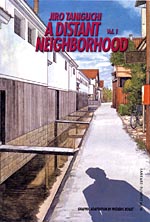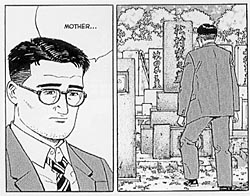 By Jiro Taniguchi
By Jiro Taniguchi
200 pages, black and white
Published by Fanfare/Ponent Mon
When I think of Jiro Taniguchi books, it’s quiet stories like the aimless strolls of The Walking Man, or the day-in-the-Meiji-period vignettes of The Times of Botchan. As a result, getting an advance copy of his book A Distant Neighborhood Vol. 1 made me joke that perhaps it was a sequel to The Walking Man where the main character got seriously lost on a walk. And at first, A Distant Neighborhood seems like it’s just going to be another quiet story about a man absorbed in his childhood memories. Once the book takes a distinct turn, though, Taniguchi finds a way to keep that aspect around while upping the proverbial ante in a fun way.
Hiroshi Nakahara is a businessman in Tokyo who one day boards the wrong train, finding himself heading to his childhood town of Kurayoshi. As the train nears the small town some three hours outside of Tokyo, Hiroshi begins thinking of his deceased mother, and how it’s the twenty-third anniversary of her death. With several hours until his return train leaves, Hiroshi visits the cemetery to pay his respects—and is suddenly 14 years old once more, back in his old life in 1963. With not only his mother’s death but also the sudden and mysterious disappearance of his father on the horizon, can Hiroshi somehow change things in his life for the better? And if it’s possible, should he?
A Distant Neighborhood Vol. 1 is an odd book because it’s almost two stories in one. There’s the obvious time travel aspect to A Distant Neighborhood, with Hiroshi struggling to make right the opportunities that he squandered as a teenager, as well as try and understand things that as a child were beyond his reach. If the book was just this alone, it’d be an entertaining read. Taniguchi moves over familiar territory but in a way that entertains and feels fresh; Hiroshi is unapologetic as he rewrites his own history, striving to be so much better. So often stories where the protagonist gets to be younger again involve some great relationship or decision that slipped away, but I love that Taniguchi hits the smaller moments from Hiroshi’s school-age days as well. The part that tickled me the most in that regard was Hiroshi trying to much harder in gym class, perhaps because it made me wonder how hard I’d really "tried" back in the day and if given a second chance I’d also be able to improve the way that Hiroshi does.
 The other half of A Distant Neighborhood is more familiar territory for Taniguchi books, though. Small town 1960s Japan comes to life under Taniguchi’s script; even if there wasn’t the time travel aspect to the book, watching Hiroshi fumble his way through relationships, talk about Natalie Wood in West Side Story, or look forward to the 1964 Olympics is all fascinating stuff. Taniguchi really understands how to make the mundane feel interesting and important, perhaps because there’s always a clarity and confident focus on even the smallest of moments. It’s so sincere in everything from a race around the track to illicitly drinking alcohol with friends, that it ends up being captivating. There’s an old cliché that there are singers that you’d listen to belting out a grocery list. In the case of Taniguchi, you’d absolutely want to read a story focusing around someone shopping off of their grocery list, because somehow he’d make it fascinating.
The other half of A Distant Neighborhood is more familiar territory for Taniguchi books, though. Small town 1960s Japan comes to life under Taniguchi’s script; even if there wasn’t the time travel aspect to the book, watching Hiroshi fumble his way through relationships, talk about Natalie Wood in West Side Story, or look forward to the 1964 Olympics is all fascinating stuff. Taniguchi really understands how to make the mundane feel interesting and important, perhaps because there’s always a clarity and confident focus on even the smallest of moments. It’s so sincere in everything from a race around the track to illicitly drinking alcohol with friends, that it ends up being captivating. There’s an old cliché that there are singers that you’d listen to belting out a grocery list. In the case of Taniguchi, you’d absolutely want to read a story focusing around someone shopping off of their grocery list, because somehow he’d make it fascinating.
If you’ve ever read or even seen a Taniguchi-drawn book, then it goes without saying that the art is gorgeous. Taniguchi draws crisp, beautifully detailed scenes, both people and the things around them. Nothing is left to the imagination, from the buttons on Hiroshi’s school uniform to the tiles on the town roofs. I think that’s certainly part of how Taniguchi is able to draw his readers into what could be such an unremarkable story, because he’s able to bring the scene to life not just in terms of script but also visually. He immerses his readers in the moment, making them feel almost like they’re part of the scene as well. If Taniguchi ever decided to switch to just drawing visual guide books of Japan, I have no doubt that not only would he make a mint, but Japanese tourism would skyrocket. I know that wherever he draws, I always end up wanting to visit by the end of the book.
At the end of the first volume of A Distant Neighborhood, Taniguchi has managed to hit the perfect "to be continued" moment. It’s hard to not be dying to see what happens next, even as Taniguchi avoids hitting a melodramatic or artificial cliffhanger. It makes me happy to see books like A Distant Neighborhood translated into English; we’d be all the poorer without Taniguchi’s delicate and beautiful comic creations. Highly recommended.
Purchase Links: Amazon.com | Powell’s Books
